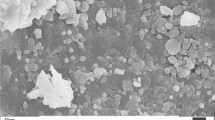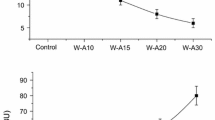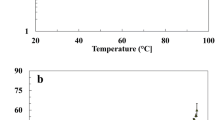Abstract
The increasing interest in quinoa in Europe has generated a large number of studies with this seed as a partial substitute for refined wheat flour in bakery products as a strategy to improve their nutritional value. However, the wide genetic diversity of this seed offers very different compositions in different varieties, which would lead to different technological behaviours in the breadmaking process. The aim of this work was to make a comparative study of the protein profile and rheological and thermal properties of three varieties of quinoa widely available commercially in Europe to study their technological potential as breadmaking ingredients with 25% replacement of wheat flour by whole quinoa flour. The results obtained during the analysis offered a view of the proteins present in the various quinoas, and of the processes of hydrolysis and generation of new bonds between wheat and quinoa proteins during the breadmaking process. The changes in the thermal and pasting properties of the bread doughs that included whole quinoa flour led to the development of baked products with different physico-chemical and textural properties, producing an increase on crumb staling. However, replacement of 25% of the wheat flour with whole quinoa flour produced only a slight decrease in the technological quality of the products. A significant increase (p < 0.05) in dietary fibre, minerals, lipids, and proteins in comparison with a whole wheat product, together with the overall consumer acceptance of the products that were developed, was conclusive for proposing replacement with quinoa flour as a strategy for nutritional improvement in the manufacture of bakery products.




Similar content being viewed by others
References
Haros M, Sanz-Penella JM (2017) Food uses of whole pseudocereals. In: Haros M, Schoenlechner R (eds) Pseudocereals: chemistry and technology. Wiley, Oxford
Sanz-Penella JM, Laparra JM, Sanz Y, Haros M (2012) Bread supplemented with amaranth (Amaranthus cruentus): effect of phytases on in vitro iron. Plant Foods for Hum Nutr 67:50–56
Garcia-Mantra I, Monedero V, Haros M (2014) Application of phytases isolated from bifidobacteria in the development of cereal-based products with amaranth. Eur Food Res Techn 238:853–862
Iglesias-Puig E, Monedero V, Haros M (2015) Bread with whole quinoa flour and bifidobacterial phytases increases dietary mineral intake bioavailability. LWT Food Sci Technol 60:71–77
Ruiz KB (2013) Quinoa biodiversity and sustainability for food security under climate change: a review. Agron Sustain Dev. https://doi.org/10.1007/s13593-013-0195-0
Regulation (EU) 2015/2283 (2015) Official J Eur Union. 25 Nov 2015
D´Amico S, Schoenlechner R, Tömököszi S, Langó B (2017) Proteins and amino acids of kernels. In: Haros M, Schoenlechner R (eds) Pseudocereals: chemistry and technology. Wiley, Oxford
Brinegar C, Goundan S (1993) Isolation and characterization of chenopodin, the 11S seed storage protein of quinoa (Chenopodium quinoa). J Agr Food Chem 41:182–185
Brinegar C, Sine B, Nwokocha L (1996) High-cysteine 2S seed storage proteins from quinoa (Chenopodium quinoa). J Agr Food Chem 44:1621–1623
Hager AS, Wolter A, Jacob F, Zannini E, Arendt EK (2012) Nutritional properties and ultra-structure of commercial gluten free flours from different botanical sources compared to wheat flours. J Cereal Sci 56:239–247
Janssen F, Pauly A, Rombouts I, Jansens KJA, Deleu LJ, Delcour JA (2017) Proteins of amaranth (Amaranthus spp.), buckwheat (Fagopyrum spp.), and quinoa (Chenopodium spp.): a food science and technology perspective. Compr Rev Food Sci F 16:39–58
Park SH, Maeda T, Morita N (2005) Effect of whole quinoa flours and lipase on the chemical, rheological and breadmaking characteristics of wheat flour. Jpn Soc Appl Glycosci 52:337–343
Lindeboom N, Chang P, Falk K, Tyler R (2005) Characteristics of starch from eight quinoa lines. Cereal Chem 82:216–222
Aluwi NA, Murphy KM, Ganjyal GM (2017) Physicochemical characterization of different varieties of quinoa. Cereal Chem 94:847–856
Reguera M, Haros M (2017) Structure and composition of kernels. In: Haros M, Schoenlechner R (eds) Pseudocereals: chemistry and technology. Wiley, Oxford
Ballester-Sanchez J, Gil JV, Haros M, Fernandez-Espinar MT (2019) Effect of incorporating white, red or black quinoa flours on the total polyphenol content, antioxidant activity and colour of bread. Plant Food Hum Nutr. https://doi.org/10.1007/s11130-019-00718-w
Association of Official Analytical Chemist (1996) Method 925.09, 996.11., 985.29, in official methods of analysis, 15th edn. AOAC, Arlington
ISO/TS (2016) Food products. Determination of the total nitrogen content by combustion according to the Dumas principle and calculation of the crude protein content. Part 2: Cereals, pulses and milled cereal products. International Organization for Standardization, Geneva, p 25
Association of Analytical Cereal Chemists (1995) Method 30–20, 08–03, 76–21 (9th edn). Method, in approved methods of American Association of Cereal Chemistry, Saint Paul
Gámbaro A, Fiszman S, Giménez A, Varela P, Salvador A (2004) Consumer acceptability compared with sensory and instrumental measures of white pan bread: sensory shelf-life estimation by survival analysis. J Food Sci 69:401–405
Laemmli UK (1970) Cleavage of structural proteins during the assembly of the head of Bacteriophage T 4. Nature 227:680–685
Fu BX, Sapirstein HD (1996) Procedure for isolating monomeric proteins and polymeric glutenin of wheat flour. Cereal Chem 73:143–152
Ng PKW, Bushuk W (1987) Glutenin of marquis wheat as a reference for estimating molecular weights of glutenin subunits by sodium dodecyl sulfate-polyacrylamide gel electrophoresis. Cereal Chem 64:324–327
Abugoch L, Romero N, Tapia CA, Silva J, Rivera M (2008) Study of some physicochemical and functional properties of quinoa (Chenopodium quinoa Willd) protein isolates. J Agr Food Chem 56:4745–4750
Abugoch L, Castro E, Tapia C, Anon MC, Gajardo P, Villarroel A (2009) Stability of quinoa flour proteins (Chenopodium quinoa Willd.) during storage. Int J Food Sci Tech 44:2013–2020
Horszwald A, Troszynska A, Del Castillo MD, Zielinski H (2009) Protein profile and sensorial properties of rye breads. Eur Food Res Technol 229:875–886
Martínez-Anaya MA (1996) Enzymes and bread flavor. J Agric Food Chem 44:2470–2480
Hansen A, Schieberle P (2005) Generation of aroma compounds during sourdough fermentation: applied and fundamental aspects. Trends Food Sci Technol 16:85–94
Di Renzo T, Reale A, Boscaino F, Messia MC (2018) Flavoring production in kamut®, quinoa and wheat doughs fermented by lactobacillus paracasei, lactobacillus plantarum, and lactobacillus brevis: a SPME-GC/MS study. Front Microbiol 9:429
Singh H (2005) A study of changes in wheat protein during bread baking using SE-HPLC. Food Chem 90:247–250
Miller AG, Gerrard JA (2005) Assessment of protein function following cross-linking by α-dicarbonyls. Ann Ny Acad Sci 1043:195–200
Tester RF (1997) In: Frazier PJ, Richmond P, Donald AM (eds) Starch, structure, functionality. Roy Soc Ch, London
Yamin FF, Lee M, Pollak LM, White PJ (1999) Thermal properties of starch in corn variants isolated after chemical mutagenesis of inbred line B73. Cereal Chem 76:175–181
Jane J, Chen YY, Lee LF, McPherson AE, Wong KS, Radosavljevic M, Kasemsuwan T (1999) Effects of amylopectin branch chain length and amylose content on the gelatinization and pasting properties of starch. Cereal Chem 76:629–637
Steffolani ME, Leon AE, Perez GT (2013) Study of the physicochemical and functional characterization of quinoa and kañiwa starches. Starch 65:976–983
Repo-Carrasco-Valencia RAM, Serna LA (2011) Quinoa (Chenopodium quinoa, Willd.) as a source of dietary fiber and other functional components. Food Sci Technol 31:225–230
Santos E, Rosell CM, Collar C (2008) Gelatinization and retrogradation kinetics of high-fiber wheat flour blends: a calorimetric approach. Cereal Chem 85:455–463
Haros M, Rosell CM, Benedito C (2002) Effect of different carbohydrases on fresh bread texture and bread staling. Eur Food Res Technol 215:425–430
Ribotta PD, León AE, Añon MC (2003) Effect of frozen storage on the gelatinization and retrogradation of amylopectin in dough baked in a differential scanning calorimeter. Food Res Int 36:357–363
Hoseney RC (1984) Gas retention in bread doughs. Cereal Food World 29:305–306
Waterschoot J, Gomand SV, Fierens E, Delcour JA (2014) Starch blends and their physicochemical properties. Starch 66:1–13
Bath DE, Shelke K, Hoseney KC (1992) Fat replacers in high-ratio layer cakes. Cereal Food World 37:495–500
Kim HYL, Yeom HW, Lim HS, Lim ST (2001) Replacement of shortening in yellow layer cakes by corn dextrins. Cereal Chem 78:261–271
Lee S, Kim S, Inglett GE (2006) Effect of shortening replacement with oat rim on the physical and rheological properties of cakes. Cereal Chem 82:120–124
Onyango C, Mutungi C, Unbehend G, Meinolf G, Lindhauer MG (2010) Rheological and baking characteristics of batter and bread prepared from pregelatinised cassava starch and sorghum and modified using microbial transglutaminase. J Food Eng 97:465–470
Michiyo W, Tomoko M, Kikuchi T, Hiroshi K, Naofumi M (2004) Application of pregerminated brown rice for breadmaking. Cereal Chem 81:450–455
Bulut-Solak B, Alonso-Miralles L, O´Mahony JA (2016) Composition, morphology and pasting properties of Orchis anatolica tuber gum. Food Hydrocoll 69:483–490
Wu G, Morris CF, Murphy KM (2014) Evaluation of texture differences among varieties of cooked quinoa. J Food Sci 79:2337–2345
Wang S, Opassathavorn A, Zhu F (2015) Influence of quinoa flour on quality characteristics of cookie, bread and Chinese steamed bread. J Texture Stud 46:281–292
Vega-Gálvez AM, Miranda J, Vergara J, Uribe J, Puente L, Martinez EA (2010) Nutrition facts and functional potential of quinoa (Chenopodium quinoa Willd.), an ancient Andean grain: a review. J Sci Food Agric 90:2541–2547
Repo-Carrasco-Valencia R, Valdez-Arana J (2017) Carbohydrates of kernel. In: Haros M, Schoenlechner R (eds) Pseudocereals: chemistry and technology. Wiley, Oxford
Stikic R, Glamoclija D, Demin M, Vucelic-Radovic B, Jovanovic Z, Milojkovic-Opsenica D, Jacobsen SE, Milovanovic M (2012) Agronomical and nutritional evaluation of quinoa seeds (Chenopodium quinoa Willd.) as an ingredient in bread formulations. J Cereal Sci 55:132–138
Lorenz K, Coulter L (1991) Quinoa flour in baked products. Plant Food Hum Nutr 41:213–223
Caussette M, Kershaw JL, Sheltod DR (1997) Survey of enzyme activities in desaponified quinoa Chenopodium quinoa Willd. Food Chem 60:587–592
Gray JA, Bemiller JN (2003) Bread staling: molecular basis and control. Compr Rev Food Sci F 2:1–21
Morita N, Hirata C, Park SH, Mitsunaga T (2001) Quinoa flour as a new foodstuff for improving dough and bread. J Appl Glycosci 48:263–270
Acknowledgements
This work was financially supported by grants QuiSalhis-Food (AGL2016-75687-C2-1-R) from the Ministry of Economy, Industry and Competitiveness (MEIC-Spain), la ValSe-Food CYTED-119RT0567 and LINCE (PROMETEO/2017/189) from the Generalitat Valenciana, Spain. The contract given to J. Ballester-Sánchez by MEIC-Spain is gratefully acknowledged. The authors express their sincere appreciation to J. M. Coll Marqués for his aid in the digital image analysis.
Author information
Authors and Affiliations
Corresponding author
Ethics declarations
Conflict of interest
The authors declare that they have no conflict of interest.
Compliance with ethics requirements
This article does not contain any studies with human or animal subjects.
Additional information
Publisher’s Note
Springer Nature remains neutral with regard to jurisdictional claims in published maps and institutional affiliations.
Rights and permissions
About this article
Cite this article
Ballester-Sánchez, J., Yalcin, E., Fernández-Espinar, M.T. et al. Rheological and thermal properties of royal quinoa and wheat flour blends for breadmaking. Eur Food Res Technol 245, 1571–1582 (2019). https://doi.org/10.1007/s00217-019-03265-5
Received:
Revised:
Accepted:
Published:
Issue Date:
DOI: https://doi.org/10.1007/s00217-019-03265-5




